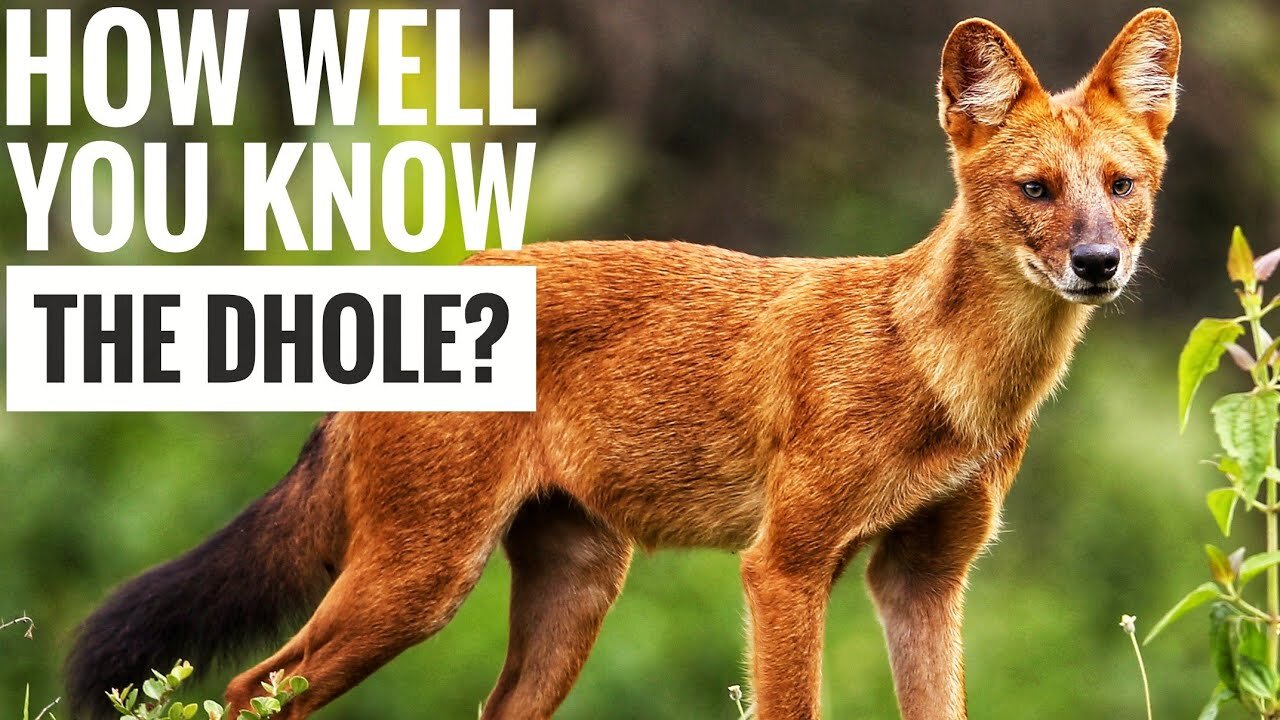Premium Only Content

Dhole || Description, Characteristics and Facts!
Dhole: Description, Characteristics, and Facts
The dhole (Cuon alpinus), also known as the Asiatic wild dog, Indian wild dog, or red dog, is a canid native to Central, South, and Southeast Asia. It is a highly social and intelligent predator, often likened to the gray wolf in its behavior and social structure, but distinguished by several unique characteristics.
Description
The dhole is a medium-sized canid with a distinct reddish coat, though its fur can range from sandy beige to a deep rust red, depending on the region. It has a bushy black-tipped tail, a pointed face, and large, rounded ears. Dholes typically weigh between 12 to 20 kilograms (26 to 44 pounds) and stand about 50 centimeters (20 inches) at the shoulder.
Characteristics
Social Structure: Dholes are pack animals, living in groups that can range from 5 to 12 individuals, though larger packs have been recorded. Pack dynamics are highly cooperative, especially in hunting and raising pups.
Hunting and Diet: Unlike other canids, dholes are known for their unique hunting strategies. They often hunt in packs, using a combination of endurance and strategic coordination to take down prey much larger than themselves, such as deer and wild boar. They also have a distinctive whistle call to communicate while hunting.
Communication: Dholes utilize a wide range of vocalizations, including whistles, screams, and clucks, which are used to coordinate during hunts and maintain pack cohesion.
Adaptability: Dholes are highly adaptable animals, capable of living in diverse habitats including tropical forests, grasslands, alpine regions, and even arid scrublands. However, they prefer dense forested areas where they can find ample cover and prey.
Reproduction: The breeding season typically occurs between October and January. Females give birth to litters of 4 to 6 pups after a gestation period of about 60 to 62 days. The entire pack participates in caring for the young, a practice known as alloparenting.
Facts
Endangered Status: The International Union for Conservation of Nature (IUCN) lists the dhole as Endangered, primarily due to habitat loss, depletion of prey base, and disease.
Cultural Significance: Dholes have various roles in the folklore and mythology of different Asian cultures, often depicted as symbols of wilderness and freedom.
Scientific Interest: Dholes are of great interest to researchers due to their complex social structures and unique vocalizations, which offer insights into canid communication and behavior.
Hashtags
#Dhole #AsiaticWildDog #EndangeredSpecies #WildlifeConservation #Canid #Predators #AnimalBehavior #Wildlife #Nature #Biodiversity #Ecology #AnimalKingdom #ConservationEfforts #WildDogs #AsianWildlife
The dhole is a fascinating and vital part of the ecosystems in which it resides, and efforts to protect this species are crucial for maintaining ecological balance and biodiversity.
-
 13:23
13:23
NinjaGamblers
21 hours ago $0.30 earnedMasaniello Betting Strategy at Roulette: Guaranteed Wins Every Time??
5.72K1 -
 1:00:43
1:00:43
Trumpet Daily
19 hours ago $4.13 earnedCanada Hates Trump More Than the Trudeau Disaster - Trumpet Daily | Apr. 29, 2025
14.2K19 -
 53:01
53:01
State of the Second Podcast
16 hours agoDisarming Americans One Law at a Time (ft. Krate Tactical)
7.43K -
 44:36
44:36
The Official Steve Harvey
11 hours ago $0.43 earnedThe journey ain't easy, but the destination is worth it
10.3K -
 3:03:52
3:03:52
Price of Reason
14 hours agoBezos & Amazon FOLD After Annoying Trump! Paramount Faces TOUGH Choice! Borderlands 4 DELAYED!
114K22 -
 1:19:29
1:19:29
Savanah Hernandez
13 hours agoRogue Judges Continue Blocking Trump's Executive Orders: The First 100 Days
85.6K48 -
 58:42
58:42
Coin Stories with Natalie Brunell
19 hours agoMacro Analysis, Financial Fragility and Bitcoin as the End Game with Preston Pysh
41.2K4 -
 2:35:37
2:35:37
TimcastIRL
10 hours agoTrump Celebrates 100 Days Amid RECORD Lawsuits & Unconstitutional Judicial Actions | Timcast IRL
221K91 -
 1:01:26
1:01:26
Glenn Greenwald
12 hours agoRapid Fire: Canada Elections, Dem's Sit-In, Israeli Taking Points Escalate; PLUS: Jewish Academics Push-Back on Antisemitism Claims | SYSTEM UPDATE #445
135K126 -
 2:20:43
2:20:43
RiftTV/Slightly Offensive
11 hours ago $20.83 earnedTotal Indian TAKEOVER: Has The WEST Completely FALLEN? | Guest: Josh Denny
74.6K30